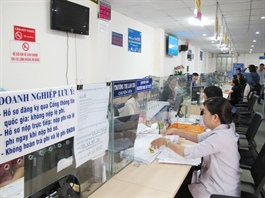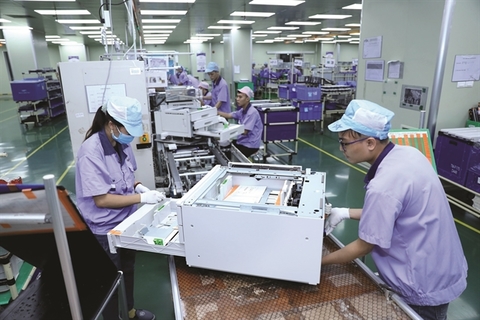Foreign trade, a highlight on Vietnam’s 2020 economic picture
Foreign trade, a highlight on Vietnam’s 2020 economic picture
In 2020, Vietnam exported goods worth an estimated US$281.5 billion and imported goods worth US$262.4 billion, up 6.5 and 3.6 percent from 2019, respectively, posting a trade surplus of US$19.1 billion, the highest level in five consecutive years since 2016, according to the Ministry of Industry and Trade (MoIT).
|
Although the Covid-19 pandemic greatly affected global trade and investment, the country ranked 22nd in the world in terms of turnover and export capacity, coming in 26th place in terms of the scale of international trade, a factor which looks set to momentum to import and export activities.
Foreign trade has been one of the three driving forces of the Vietnamese economy for many years. Vietnam fulfilled the import and export targets of the 2011-2020 period ahead of schedule - despite the severe effects of the pandemic in 2020.
In the first half of 2020, when foreign trade fell short of the target, the MoIT and other authorities made strenuous efforts to create the best conditions for import and export enterprises, while businesses in the field adopted solutions to increase goods export value.
Phan Van Chinh, Director of the MoIT’s Agency of Foreign Trade, said taking the initiative in preparing materials by textile and garment, and leather and footwear enterprises, for example, helped them maintain export growth and contribute to the country’s export achievement.
According to the latest statistics from the MoIT, Vietnam exported goods worth an estimated US$281.5 billion in 2020, up 6.5 percent from 2019, while the growth in 2019 was 8.4 percent over 2018. The country imported goods worth an estimated US$262.4 billion in the same year, up 3.6 from 2019, taking the country’s total foreign trade value to an estimated US$543.9 billion, US$26.64 billion higher than in 2019.
Shift from agriculture to industry
Notably, Vietnam has been changing its export goods structure towards increasing the contribution of processed and industrial goods and decreasing the proportion of raw materials and semi-finished products in compliance with Vietnam’s export and import development strategy for the 2011-2020 period with a vision to 2030. This has paved the way for Vietnamese goods to participate more deeply in global production and supply chains. Accordingly, export growth over the past two years was no longer driven by agricultural and aquatic products but industrial goods.
Nonetheless, a bumper rice crop in 2020 led Vietnam to surpass Thailand and India to become the world’s biggest country in terms of rice export prices. Since the EU-Vietnam Free Trade Agreement (EVFTA) took effect in early August 2020, Vietnam’s footwear exports have grown encouragingly. More than 1,700 Vietnamese enterprises can provide the market with over 1.1 billion pairs of shoes and almost 400 million backpacks and bags per year. The EVFTA and the Comprehensive and Progressive Agreement for Trans-Pacific Partnership (CPTPP) are expected to drive growth further in footwear and handbag industries in 2021.
Tran Thanh Hai, Deputy Director of the MoIT’s Agency of Foreign Trade, said that despite Covid-19 disrupting supply chains and leading to the cancellation of export orders, relevant ministries and sectors have moved to intensify trade promotion activities for businesses as they seek partners and outlets for their products.
Growing trade surplus
This was reflected in the decision to shift some production to essential goods such as face masks, gloves, as well as medical protective clothing for epidemic prevention and control, all of which have helped to accelerate exports, he added.
Vietnam’s foreign trade surplus increased from US$1.77 billion in 2016 to US$2.11 billion in 2017, US$6.83 billion in 2018, US$10.87 billion in 2019 and US$19.1 billion in 2020. This is an encouraging achievement in the context of the Covid-19 pandemic. The trade surplus helped maintain macroeconomic stability, including stability of foreign exchange reserves and exchange rates, encouraging businesses to continue investing in production development.
Economists advised local firms to make radical reforms by restructuring sectors and trade promotion procedures, as well as improving product quality to seize upon opportunities presented by free trade agreements.
Dr. Le Quoc Phuong, former deputy director of the MoIT’s Information Center, underscored the importance of improving quality, added value, and competitiveness, as opposed to increasing export volume, by exporting high-tech products, developing supporting industries, and building stronger brands.
To increase total export value by approximately five percent this year, the MoIT plans to make institutional reforms and handle issues related to trade protectionism, trade remedies, and the impact of the Covid-19 pandemic on supply chains.
Furthermore, the ministry will continue to focus on digital transformation in addition to developing new business models based on digital technologies such as e-commerce, whilst enhancing the capability of local enterprises to participate in global value chains.
Tran Thanh Hai, Deputy Director of the MoIT’s Agency of Foreign Trade, said hurdles faced by firms must be removed in order to maximize the benefits of the EVFTA, and information on rules of origin and other requirements set by foreign importers must be obtained and studied in an effort to increase exports.
| Deputy Minister of Industry and Trade Do Thang Hai: The year 2020 was a difficult one for all economic sectors, including imports and exports. Nonetheless, Vietnam’s foreign trade achievements were remarkable, a bright spot on the country’s economic picture and an important precondition for the national economy to continue sustainable development in 2021. |


























